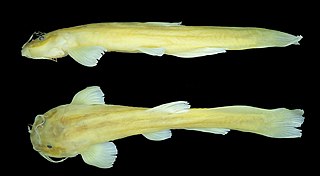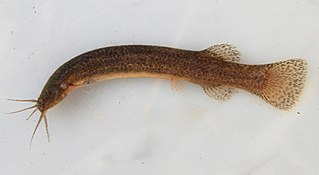
Trichomycteridae is a family of catfishes commonly known as pencil catfishes or parasitic catfishes. This family includes the candiru fish, feared by some people for its alleged habit of entering into the urethra of humans. They are one of the few parasitic chordates. Another species is the life monsefuano which was important to the Moche culture and still an important part of Peruvian cuisine.

Trichomycterus is a genus of fish in the family Trichomycteridae, the largest genus of its family with over 170 species currently described. This genus is native to freshwater habitats in Central and South America. These fish are generally small, usually about 5 to 15 cm (2–6 in) in standard length, although the largest, T. rivulatus, can reach more than twice this size. Species differ from one another primarily in body proportions, fin ray counts and colouration. Despite their relatively small size, some, such as T. punctulatus, support fisheries and are important in the local cuisine.

Phreatobius is a genus of very small catfishes from tropical South America.

Eremophilus mutisii is a species of catfish of the family Trichomycteridae, and the only member of its genus. This fish grows to about 30 centimetres (12 in) and originates from the Bogotá River basin, which is a tributary of the Magdalena River. It has probably been introduced to Ubaté, Chiquinquirá, and Tundama valleys, Colombia.
Glaphyropoma is a genus of small pencil catfishes native to Bahia in Brazil.
Malacoglanis gelatinosus is a species of catfish of the family Trichomycteridae, and the only species of the genus Malacoglanis. This fish grows to about 2.0 centimetres (.79 in) SL. and is native to the Caquetá River basin of Colombia. Stauroglanis is the sister group to a monophyletic group formed by Malacoglanis and Sarcoglanis.
Sarcoglanis simplex is a species of catfish of the family Trichomycteridae, and the only species of the genus Sarcoglanis. This fish originates from the upper Rio Negro basin of Brazil. Stauroglanis is the sister group to a monophyletic group formed by Malacoglanis and Sarcoglanis.

Copionodon is a genus of catfishes of the family Trichomycteridae. It includes three species, C. lianae, C. orthiocarinatus, and C. pecten.
Stauroglanis gouldingi is a species of catfish of the family Trichomycteridae, and the only species of the genus Stauroglanis.
Ammoglanis is a genus of pencil catfishes native to South America.
Microcambeva is a genus of catfishes of the family Trichomycteridae.
Glanapteryx is a genus of catfishes native to South America.
Pygidianops is a genus of pencil catfishes native to South America.
Typhlobelus is a genus of pencil catfishes native to South America.
The Sarcoglanidinae are a subfamily of catfishes of the family Trichomycteridae. It includes six genera: Ammoglanis, Malacoglanis, Microcambeva, Sarcoglanis, Stauroglanis, and Stenolicmus.
Ochmacanthus is a genus of pencil catfishes native to South America. These species are distributed in South America. O. alternus and O. orinoco originate from the Rio Negro and Orinoco River basins of Brazil and Venezuela. O. batrachstoma inhabits the Paraguay River basin in Brazil. O. flabelliferus lives in river drainages in Guyana and Venezuela. O. reinhardtii is known from the Amazon River basin in Brazil and drainages in French Guiana.

Ituglanis is a genus of small freshwater fish in the family Trichomycteridae native to South America. Their greatest diversity seems to occur in the Amazon River basin. Most species inhabit leaf litter, with several species living in caves.

Copionodon pecten is a species of catfishes of the family Trichomycteridae. It is found in the Mucujê River, a tributary of Paraguaçu River in Bahia, Brazil. This species reaches a length of 6.2 cm (2.4 in).
Copionodon orthiocarinatus is a species of catfish of the family Trichomycteridae. It is found in the Mucujê River, a tributary of Paraguaçu River in Bahia, Brazil. This species reaches a length of 7.5 cm (3.0 in).
Copionodon lianae is a species of catfishes of the family Trichomycteridae. It is found in the Grisante River, a tributary of the Mucujê River, which is a tributary of the Paraguaçu River in Bahia, Brazil. This species reaches a length of 6.2 cm (2.4 in).






